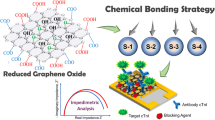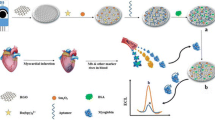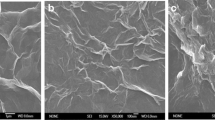Abstract
A composite consisting of gold nanoparticles and reduced graphene oxide (AuNPs@rGO) was electrochemically prepared in-situ on a screen printed electrode (SPE) which then was used as an immunosensor for the cardiac biomarker myoglobin. The nanocomposite was characterized by transmission electron microscopy (TEM, scanning electron microscopy (SEM), atomic force microscopy, FTIR and electrochemical impedance spectroscopy. For FTIR, TEM and SEM, the deposition was done on indium tin oxide coated glass plates. The immunosensor was obtained by immobilization of in-house generated antibody against cardiac myoglobin on the electrode surface. The immunosensing response was monitored using differential pulse voltammetry, which showed a reduction peak at ~ −0.5 V (vs. Ag/AgCl). The reduction peak arises from the reduction of iron moiety present in the heme group of myoglobin. The immunosensor exhibited dynamic linearity range from 1 ng.mL−1 to 1400 ng.mL−1 with the detection limit of ~0.67 ng.mL−1 for cardiac myoglobin. The obtained result was almost eight times better (in terms of detection limit) than that obtained with ELISA tests (with detection limit of ~4 ng.mL−1) using the same antibodies. The immunosensor was applied to analyze spiked serum samples also.

The study reports on gold nanoparticle-reduced graphene oxide (AuNPs@rGO) composite based immunosensor for the cardiac biomarker myoglobin. The composite has been synthesized electrochemically in which auric acid and graphene oxide are simultaneously reduced on screen printed electrodes. The immunosensor is sensitive in the range from 1 to 1400 ng.mL−1.





Similar content being viewed by others
References
Wu AH, Apple FS, Gibler WB, Jesse RL, Warshaw MM, Valdes R Jr.(1999) National Academy of clinical biochemistry standards of laboratory practice: recommendations for the use of cardiac markers in coronary artery diseases. Clinical Chem 45:1104
Apple FS, Jesse RL, Newby LK, Wu AH, Christenson RH, Cannon CP, Francis G, Morrow DA, Ravkilde J, Storrow AB, Tang W (2007) National Academy of clinical biochemistry and IFCC committee for standardization of markers of cardiac damage laboratory medicine practice guidelines: analytical issues for biochemical markers of acute coronary syndromes. Circulation 115:e352–e355
Mishra SKS, Kumar A, Rajesh (2014) Bio-functionalized Pt nanoparticles based electrochemical impedance immunosensor for human cardiac myoglobin. RSC Adv 4:21267
Billah M, Hays HCW, Millner PA (2008) Development of a myoglobin impedimetric immunosensor based on mixed self-assembled monolayer onto gold. Microchim Acta 160:447
Suprun EV, Shilovskaya AL, Lisitsa AV, Bulko TV, Shumyantseva VV, Archakov AI (2011) Electrochemical immunosensor based on metal nanoparticles for cardiac myoglobin detection in human blood plasma. Electroanal 23:1051
Zhang X, Zhang J, Zhou D, Wang G (2012) Electrodeposition method synthesise gold nanoparticles-Prussian blue-graphene nanocomposite and its application in electrochemical sensor for H2O2. Micro Nano Lett IET 7:60
Pu Z, Liu Q, Asiri AM, Obaid AY, Sun X (2014) One-step electrodeposition fabrication of graphene film-confined WS2 nanoparticles with enhanced electrochemical catalytic activity for hydrogen evolution. Electrochim Acta 134:8
Ye W, Zhang X, Chen Y, Du Y, Zhou F, Wang C (2013) Pulsed electrodeposition of reduced graphene oxide on glass carbon electrode as an effective support of electrodeposited pt microspherical particles: nucleation studies and the application for methanol electro-oxidation. Int J Electrochem Sci 8:2122–2139
Ramachandran R, Mani V, Chen S-M, Saraswathi R, Lou B-S (2013) Recent trends in graphene based electrode materials for energy storage devices and sensors applications. Int J Electrochem Sci 8:11680
Nasrollahzadeh M, Babaei F, Fakhri P, Jaleh B (2015) Synthesis, characterization, structural, optical properties and catalytic activity of reduced graphene oxide/copper nanocomposites. RSC Adv 5:10782
Li J, Feng H, Li J, Feng Y, Zhang Y, Jiang J, Qian D (2015) Fabrication of gold nanoparticles-decorated reduced graphene oxide as a high performance electrochemical sensing platform for the detection of toxicant Sudan I. Electrochim Acta 167:226
Liu Y, Dong Y, Guo CX, Cui Z, Zheng L, Li CM (2012) Protein-directed in situ synthesis of gold nanoparticles on reduced graphene oxide modified electrode for nonenzymatic glucose sensing. Electroanal 24:2348
Li S-J, Deng D-H, Shi Q, Liu S-R (2012) Electrochemical synthesis of a graphene sheet and gold nanoparticle-based nanocomposite, and its application to amperometric sensing of dopamine. Microchim Acta 177:325
Qin X, Li Q, Asiri AM, Al-Youbi AO, Sun A (2013) One-pot synthesis of Au nanoparticles/reduced graphene oxide nanocomposites and their application for electrochemical H2O2, glucose, and hydrazine sensing. Gold Bull 47:3
Yang J, Sundaram G (2013) Electrochemically reduced graphene oxide sheets for use in high performance supercapacitors. Carbon 51:36
Taleat Z, Khoshroo A, Mazloum-Ardakani M (2014) Screen-printed electrodes for biosensing: a review (2008–2013). Microchim Acta 181:865
Gao H, Duan H (2015) 2D and 3D graphene materials: preparation and bioelectrochemical applications. Biosens Bioelect 65:404
Low CTJ, Walsh FC, Chakrabarti MH, Hashim MA, Hussain MA (2013) Electrochemical approaches to the production of graphene flakes and their potential applications. Carbon 54:1
Wang X, Kholmanov I, Chou H, Ruoff RS (2015) Simultaneous electrochemical reduction and delamination of graphene oxide films. ACS Nano 9:8737
Choi HC, Shim M, Bangsaruntip S, Dai H (2002) Spontaneous reduction of metal ions on the sidewalls of carbon nanotubes. J Am Chem Soc 124:9058
Goncalves G, Marques PAAP, Granadeiro CM, Nogueira HIS, Singh MK, Gracio J (2009) Surface modification of graphene nanosheets with gold nanoparticles: the role of oxygen moieties at graphene surface on gold nucleation and growth. Chem Mat 21:4796
Sharma P, Tuteja SK, Bhalla V, Shekhawat G, David VP, Suri CR (2013) Bio-functionalized graphene–graphene oxide nanocomposite based electrochemical immunosensing. Biosens Bioelect 39:99
Xiaochen D, Huang W, Chen P (2011) In situ synthesis of reduced graphene oxide and gold nanocomposites for nanoelectronics and biosensing. Nano Res Lett 6:60
Yang J, Deng S, Lei J, Ju H, Gunasekaran S (2011) Electrochemical synthesis of reduced graphene sheet–AuPd alloy nanoparticle composites for enzymatic biosensing. Biosens Bioelect 29:159
Chen L, Tang Y, Wang K, Liu C, Luo S (2011) Direct electrodeposition of reduced graphene oxide on glassy carbon electrode and its electrochemical application. Electrochem Comm 13:133
Caschera D, Federici F, Zane D, Focanti F, Curulli A, Padeletti G (2009) Gold nanoparticles modified GC electrodes: electrochemical behaviour dependence of different neurotransmitters and molecules of biological interest on the particles size and shape. J Nano Res 11:1925
Liu A-L, Zhong G-X, Chen J-Y, Weng S-H, Huang H-N, Chen W, Lin L-Q, Lei Y, Fu F-H, Sun Z-L, Lin X-H, Lin J-H, Yang S-Y (2013) A sandwich-type DNA biosensor based on electrochemical co-reduction synthesis of graphene-three dimensional nanostructure gold nanocomposite films. Anal Chim Acta 767:50
Kneten KR, McCreery RL (1992) Effects of redox system structure on electron-transfer kinetics at ordered graphite and glassy carbon electrodes. Anal Chem 64:2518
Wang X, You Z, Sha H, Gong S, Niu Q, Sun W (2014) Direct electrochemistry and electrocatalysis of myoglobin using an ionic liquid-modified carbon paste electrode coated with Co3O4 nanorods and gold nanoparticles. Microchim Acta 181:767
Zhao Z, Cao L, Hu A, Zhang W, Ju X, Zhang Y, Sun W (2013) Direct electrochemistry and electrocatalysis of myoglobin with comoo4 nanorods modified carbon ionic liquid electrode. Bull Kor Chem Soc 34:475
Paulo TF, Diógenes IC, Abruña HD (2011) Direct electrochemistry and electrocatalysis of myoglobin immobilized on l-cysteine self-assembled gold electrode. Langmuir 27:2052
Liu S, Ju H (2003) Electrocatalysis via direct electrochemistry of myoglobin immobilized on colloidal gold nanoparticles. Electroanal 15:1488
Acknowledgments
S.K.T. is thankful to Council of Scientific and Industrial Research (CSIR), New Delhi, India, for granting Senior Research Fellowship. The financial support from CSIR under XIIth five year plan in network projects ‘BIOCERAM’– ESC 0103 is acknowledged.
Author information
Authors and Affiliations
Corresponding author
Ethics declarations
Conflict of interest
The author(s) declare that they have no competing interests.
Additional information
Suman Singh and Satish K. Tuteja contributed equally to this paper.
Electronic supplementary materials
ESM 1
(DOCX 2.28 mb)
Rights and permissions
About this article
Cite this article
Singh, S., Tuteja, S.K., Sillu, D. et al. Gold nanoparticles-reduced graphene oxide based electrochemical immunosensor for the cardiac biomarker myoglobin. Microchim Acta 183, 1729–1738 (2016). https://doi.org/10.1007/s00604-016-1803-x
Received:
Accepted:
Published:
Issue Date:
DOI: https://doi.org/10.1007/s00604-016-1803-x




